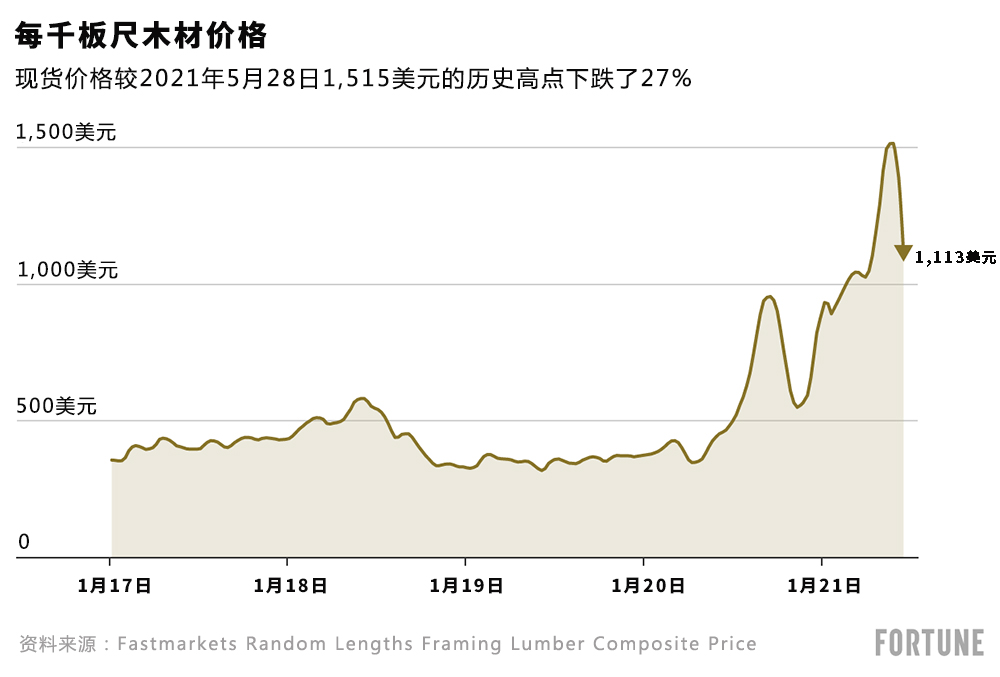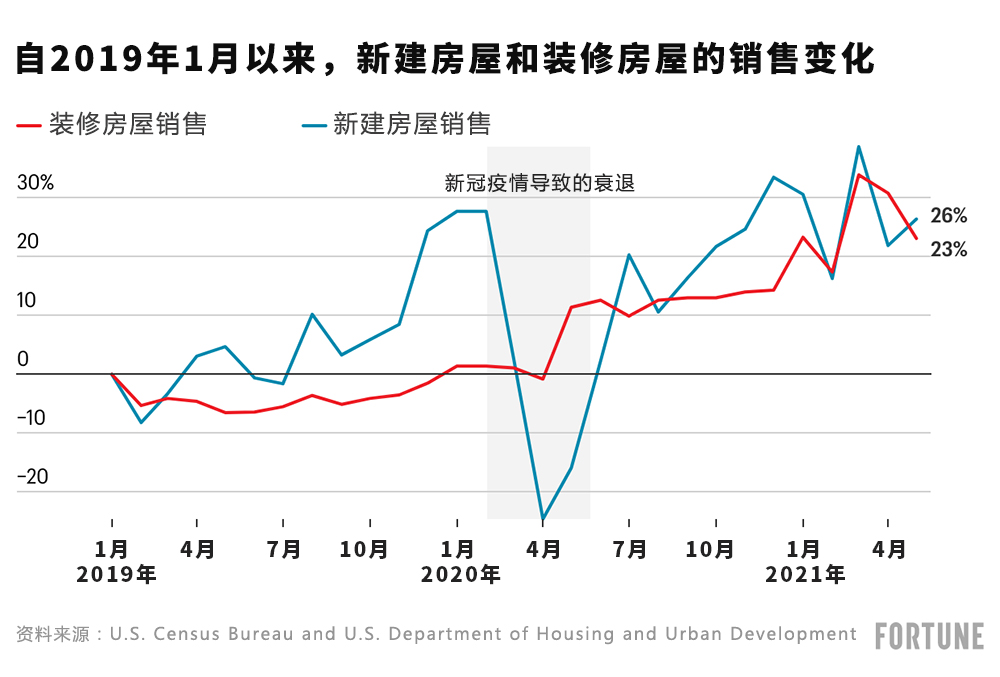在今年春天攀升至历史高点之后,木材价格正在迅速回落。根据行业出版物Random Lengths发布的数据,每千板尺木材的现货价格在上周下跌211美元至1,113美元,较5月28日1,515美元的历史高点下跌了27%。
Sherwood Lumber公司的首席执行官安迪•古德曼告诉《财富》杂志:“我们正处于自由落体状态。”在木材期货市场,价格的下跌幅度更大——自5月10日突破1,700美元以来,已经下跌了47%。
为什么木材价格现在才开始回落?过高的木材价格终于让一些房屋建筑商和自己动手修缮的房主被迫放弃了原有计划。5月的新屋开工量较3月创下的14年高点下降了8.8%。与此同时,自3月创下历史新高以来,家装销量下降了8.1%。此外,在创纪录高价的激励下,锯木厂和伐木场争相提高产量。而供给上升和需求下降,向来都是促使价格调整的完美配方。
Deacon Lumber公司的首席执行官斯廷森•迪恩也认为,直冲云霄的价格让许多买家望而却步,这在一定程度上缓解了木材短缺问题。但他随即指出,木材价格回落的另一个原因是,导致春季木材历史性轧空的动力已经出尽,而且不会再发生。
“当木材价格在春季被空头挤压至1,700美元的时候,建筑商的感受并不像他们的供应商那么强烈。早在去年冬季,建筑商就向供应商锁定了价格;供应商不得不高价买单。现在,供应商不再提供远期价格锁定,所以他们不会再次受到空头挤压。”斯廷森告诉《财富》杂志,“现在的市场形势不同于春季,不再有轧空动能了。”

木材的价格或许正在崩溃——但仍然远高于新冠疫情前的水平。现货价格仍然比2020年春季高211%。在新冠疫情爆发前,木材价格一直在每千板尺350美元到500美元之间波动。
“在未来几周,木材价格还会继续下探,然后逐渐趋稳。买家需要在未来几周填补库存。”古德曼告诉《财富》杂志。他认为,高企的价格可能会持续数年。“一般来说,一切都会回归均值,但我们认为,未来一至三年的均值将高于过去10至15年的均值。这是因为除通胀因素之外,我们预计需求将维持高位。”
《财富》杂志在过去几周采访的业内人士一致认为,木材价格可能在今年年底前跌至每千板尺600美元。随着木材的现货或批发价格下跌,这些折扣需要一段时间才能够体现在诸如家得宝(Home Depot)这类大卖场的价格标签上。不过,即使木材价格有所缓解,你家新围栏或露台的建造成本仍然会比危机前高很多。

为什么价格不太可能很快回归到新冠疫情爆发前的水平呢?尽管建造房屋和自己动手修缮房屋的热潮有所消退,但仍然十分火爆。5月,新屋开工量比2019年1月的水平高出26%。与此同时,家装销量在同一时期增长了23%。
正如《财富》杂志此前报道的那样,这场历史性木材短缺是新冠疫情掀起的完美风暴造成的。疫情在2020年春天爆发时,正值锯木厂因为担心房地产市场崩溃而削减产量并清理库存之际。房地产市场并未崩溃——相反的一幕发生了。美国人竞相涌入家得宝和劳氏(Lowe 's)购买自建项目所需的材料,而经济衰退引发的低利率也刺激了房地产市场的繁荣。与此同时,大批千禧一代开始进入购房高峰期,让原本就热火朝天的房地产市场变得如火如荼。这波景气导致住房库存枯竭,促使买家争先寻找新房源。家庭装修和建造新房需要大量的木材,但锯木厂无法跟上井喷的市场需求。(财富中文网)
译者:任文科
在今年春天攀升至历史高点之后,木材价格正在迅速回落。根据行业出版物Random Lengths发布的数据,每千板尺木材的现货价格在上周下跌211美元至1,113美元,较5月28日1,515美元的历史高点下跌了27%。
Sherwood Lumber公司的首席执行官安迪•古德曼告诉《财富》杂志:“我们正处于自由落体状态。”在木材期货市场,价格的下跌幅度更大——自5月10日突破1,700美元以来,已经下跌了47%。
为什么木材价格现在才开始回落?过高的木材价格终于让一些房屋建筑商和自己动手修缮的房主被迫放弃了原有计划。5月的新屋开工量较3月创下的14年高点下降了8.8%。与此同时,自3月创下历史新高以来,家装销量下降了8.1%。此外,在创纪录高价的激励下,锯木厂和伐木场争相提高产量。而供给上升和需求下降,向来都是促使价格调整的完美配方。
Deacon Lumber公司的首席执行官斯廷森•迪恩也认为,直冲云霄的价格让许多买家望而却步,这在一定程度上缓解了木材短缺问题。但他随即指出,木材价格回落的另一个原因是,导致春季木材历史性轧空的动力已经出尽,而且不会再发生。
“当木材价格在春季被空头挤压至1,700美元的时候,建筑商的感受并不像他们的供应商那么强烈。早在去年冬季,建筑商就向供应商锁定了价格;供应商不得不高价买单。现在,供应商不再提供远期价格锁定,所以他们不会再次受到空头挤压。”斯廷森告诉《财富》杂志,“现在的市场形势不同于春季,不再有轧空动能了。”
木材的价格或许正在崩溃——但仍然远高于新冠疫情前的水平。现货价格仍然比2020年春季高211%。在新冠疫情爆发前,木材价格一直在每千板尺350美元到500美元之间波动。
“在未来几周,木材价格还会继续下探,然后逐渐趋稳。买家需要在未来几周填补库存。”古德曼告诉《财富》杂志。他认为,高企的价格可能会持续数年。“一般来说,一切都会回归均值,但我们认为,未来一至三年的均值将高于过去10至15年的均值。这是因为除通胀因素之外,我们预计需求将维持高位。”
《财富》杂志在过去几周采访的业内人士一致认为,木材价格可能在今年年底前跌至每千板尺600美元。随着木材的现货或批发价格下跌,这些折扣需要一段时间才能够体现在诸如家得宝(Home Depot)这类大卖场的价格标签上。不过,即使木材价格有所缓解,你家新围栏或露台的建造成本仍然会比危机前高很多。
为什么价格不太可能很快回归到新冠疫情爆发前的水平呢?尽管建造房屋和自己动手修缮房屋的热潮有所消退,但仍然十分火爆。5月,新屋开工量比2019年1月的水平高出26%。与此同时,家装销量在同一时期增长了23%。
正如《财富》杂志此前报道的那样,这场历史性木材短缺是新冠疫情掀起的完美风暴造成的。疫情在2020年春天爆发时,正值锯木厂因为担心房地产市场崩溃而削减产量并清理库存之际。房地产市场并未崩溃——相反的一幕发生了。美国人竞相涌入家得宝和劳氏(Lowe 's)购买自建项目所需的材料,而经济衰退引发的低利率也刺激了房地产市场的繁荣。与此同时,大批千禧一代开始进入购房高峰期,让原本就热火朝天的房地产市场变得如火如荼。这波景气导致住房库存枯竭,促使买家争先寻找新房源。家庭装修和建造新房需要大量的木材,但锯木厂无法跟上井喷的市场需求。(财富中文网)
译者:任文科
After climbing to historic heights this spring, lumber prices are headed back down—fast. Last week the cash price per thousand board feet of lumber fell $211 to $1,113, according to industry trade publication Random Lengths. That's down 27% from its $1,515 all-time high on May 28.
"We are in a free fall," Andy Goodman, CEO of Sherwood Lumber, told Fortune. In the lumber futures market, prices are down even more— dropping 47% since going above $1,700 on May 10.
Why are lumber prices finally correcting? The exorbitant price of lumber finally has some homebuilders and DIYers backing off. New home construction in May is down 8.8% from the 14-year high set in March. While home improvement sales are down 8.1% since setting an all-time high in March. Incentivized by record-high prices, sawmills and loggers rushed to tick up production. Of course, rising supply and falling demand is a perfect recipe for a price correction.
Stinson Dean, CEO of Deacon Lumber, agreed that buyers balking at sky-high prices are helping to alleviate the problem. But, he said, it's also down because the dynamic that led to the historic lumber squeeze in the spring has already played out—and won't happen again.
"The spring short squeeze to $1,700 wasn't really felt by the builders as much as it was [by] their vendors. The builders locked in their price with the vendors in the winter and the vendors had to cover it at high prices...now vendors aren't offering forward price locks so they don't get squeezed again," Stinson told Fortune. "The short squeeze dynamics are not there today like they were in the spring."
The price of lumber may be crashing—but we're still far above pre-pandemic levels. The cash price is still up 211% from spring 2020. Prior to the pandemic, lumber prices fluctuated between $350 to $500 per thousand board feet.
"Prices will continue to decline for the next few weeks and gradually stabilize. Buyers will need to fill inventories in the coming weeks," Goodman told Fortune. He believes elevated prices could last years: "In general everything reverts back to the mean, however we believe that the mean for the next one to three years will be higher than the past 10 to 15-year mean. This is due to the high demand we expect on top of inflation."
The consensus among industry insiders Fortune has interviewed over the past few weeks is that prices could drop to $600 per thousand board feet before the end of the year. As the cash, or wholesale, lumber price falls it will take time for those discounts to be reflected in big box stores like Home Depot. But even with this lumber price relief, your new fence or deck is still going to cost a lot more than it would have pre-crisis.
Why are prices unlikely to reach pre-pandemic levels anytime soon? Even though homebuilding and DIY are slowing a bit, they're still running hot. In May, new home construction was 26% above Jan. 2019 levels. Meanwhile, home improvement sales are up 23% during the same period.
As Fortune has previously reported, this historic lumber shortage was spurred by a perfect storm of factors set off during the pandemic. When COVID-19 broke out in spring 2020, sawmills cut production and unloaded inventory in fears of a looming housing crash. The crash didn't happen—instead, the opposite occurred. Americans rushed to Home Depot and Lowe’s to buy up materials for do-it-yourself projects, while recession-induced interest rates helped spur a housing boom. That boom, which was exacerbated by a large cohort of millennials starting to hit their peak homebuying years, dried up housing inventory and sent buyers in search of new construction. Home improvements and construction require a lot of lumber, and mills couldn't keep up.






